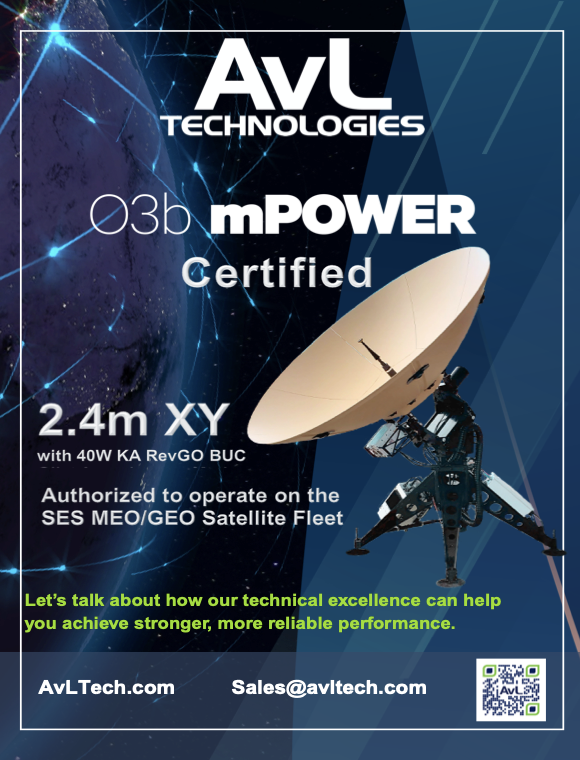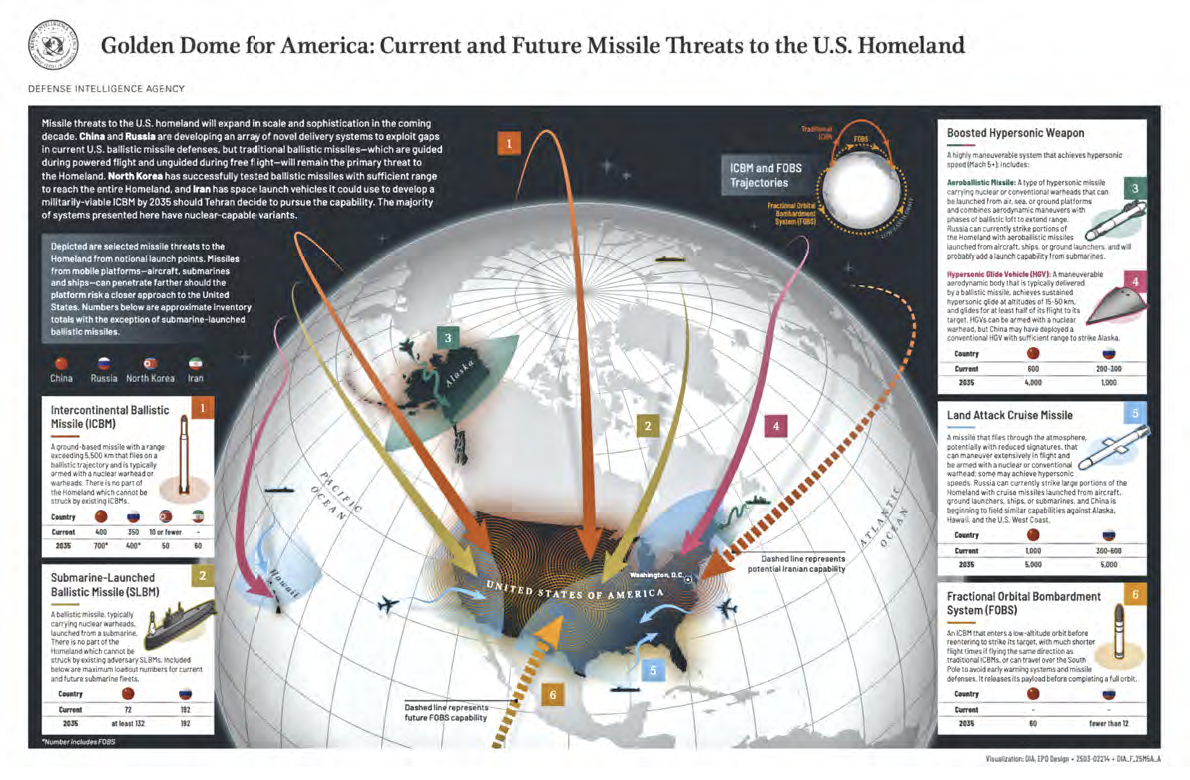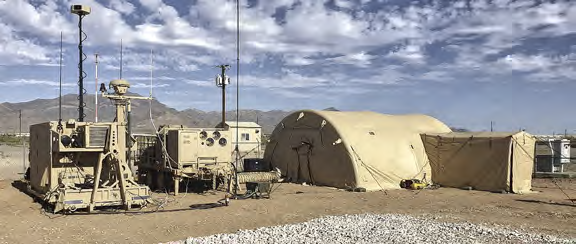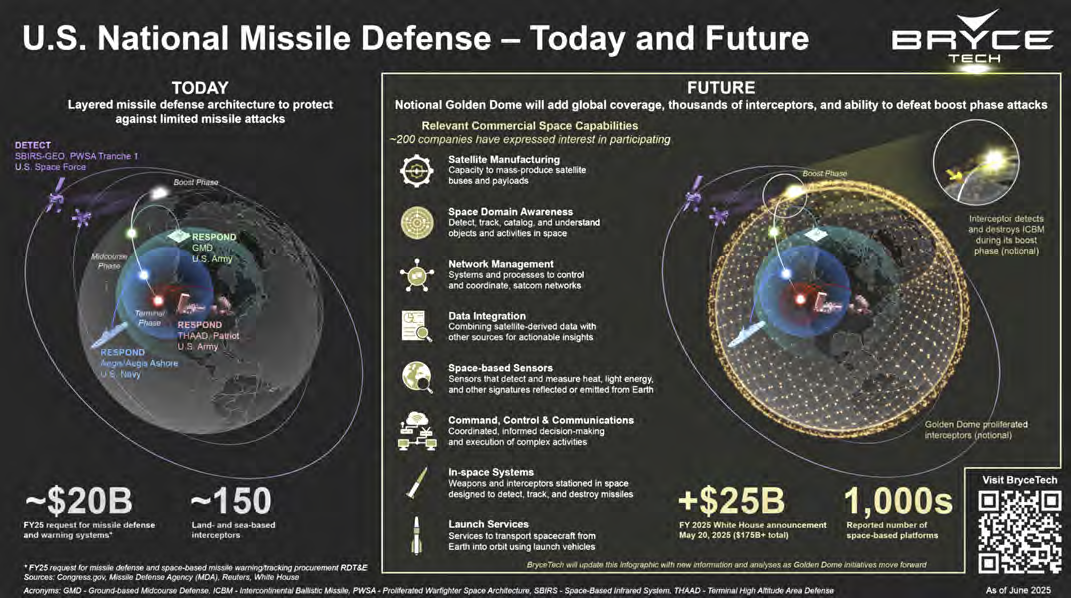Subject matter expertise: Bryce Tech Department of Defense, Defense Intellligence Agency, Lockheed Martin Missile Defense Agency, Northrop Grumman and the Satnews editors
Revolutionizing U.S. Homeland Missile Defense Golden Dome stands as a layered defense shield, safeguarding the American homeland with unwavering precision, ensuring the security and resilience of our nation.

Golden Dome for America is a revolutionary concept to further the goals of peace through strength and President Trump’s vision for deterring adversaries from attacks on the homeland.
This next generation defense shield will identify incoming projectiles, calculate trajectory and deploy interceptor missiles to destroy them mid-flight, safeguarding the homeland and projecting American Strength.
_____________________
THE CHALLENGE
_____________________
Mobilize American industry and innovation to deliver the first Golden Dome for America defenses by the end of next year.
While we deploy that combat-proven foundation, the company will bring in the best and brightest of American innovation to rapidly develop game-changing tech—like space-based interceptors and hypersonic defenses—that will ensure America’s Golden Dome stays well ahead of adversary threats.
____________________
THE APPROACH
____________________
The fastest, most efficient path to a Golden Dome for America is to bring the best of the defense and commercial industries together as a whole of industry approach.
 This is a Manhattan Project-scale mission, one that is both urgent and crucial to America’s security.
This is a Manhattan Project-scale mission, one that is both urgent and crucial to America’s security.
Lockheed Martin is ready to partner with the best in industry, emerging and large technology companies together to safeguard our nation. The company lead the MDA’s National Team for C2BMC and successfully built the world’s most powerful missile defense software network, which connects forces around the world 24x7.
The firm has proven its ability to work across industry to bring the best of the best to the warfighter and Lockheed Martin has existing partnerships with defense, commercial tech companies and newer contractors to deliver proven and next-generation capabilities to the fight.
___________
THE RISK
___________
If a missile is coming over the horizon, that’s not the time to do beta testing. Build on a combat-proven foundation today, while innovating for the future.
This mission is too vital to leave to chance. Missile defense requires more than just AI or software expertise.
The mission is about connecting a global array of complex systems that need to work at lightning speed and with pinpoint precision at the mission’s moment of truth.
___________________
THE SOLUTION
___________________

Lockheed Martin has the proven, mission-tested capabilities and track record of integration to bring this effort to life.
With that combat-proven foundation in place, our open architecture approach allows the best of commercial, defense and newer contractors to build game-changing innovations into the system as they become available, expanding range, territorial coverage, accelerating timelines, and strengthening deterrence.
This mission can’t be left to chance with unproven technology—the mission must be met with proven capability providers, who can deliver the greatest innovation, with high reliability, at scale, and ahead of need.
Focused on the mission and the partnerships needed to succeed, the company’s innovative solutions will safeguard the homeland and ensure America’s continued security and prosperity.
Building the American Shield: It Starts with Detection Lockheed Martin’s S-band radar technology comes in to the picture here....
This technology powers next-generation radar systems such as the Long Range Discrimination Radar (LRDR), TPY-6 and SPY-7, delivering modular, high-power coverage across land, sea, and space.
________
LRDR
________
The Long Range Discrimination Radar (LRDR) program is the backbone of the Missile Defense Agency’s layered defense strategy to protect the U.S. homeland from ballistic missile attack.
LRDR is a long range radar that will provide precision metric data to improve ballistic defense discrimination and replace existing sensors in the Ballistic Missile Defense System (BMDS).
With a mission of protecting the homeland, LRDR will keep pace with evolving ballistic missile threats and increase the effectiveness of ground based interceptors.
The program is built upon the U.S. government’s long-term investment in S-Band radar, ground-based radar, and systems integration, as evident in such Lockheed Martin technologies as the Aegis Combat System, Space Fence and Aegis Ashore.
This solid state, gallium nitride (GaN)-based radar uses the company’s Open GaN Foundry model, which leverages relationships with strategic GaN suppliers.
LRDR combines proven solid-state radar technologies with proven ballistic missile defense algorithms, all based upon an open architecture platform capable of meeting future growth.
Designed for flexibility and speed, this technology forms the first line of detection in today’s layered missile defense architecture.
_____________________
Why This Matters
_____________________
This isn’t just a radar, it’s a strategic enabler with mission-critical benefits and the powerful S-band technology provides:
Early, persistent tracking of ballistic missiles from launch to midcourse, giving commanders time and clarity to make the correct decisions
High-fidelity discrimination distinguishing real threats from decoys, increasing effectiveness and conserving costly interceptors.
A future-proof design with open architecture supporting software upgrades and seamless integration across evolving defense systems, ready to counter advanced threats.
___________________
Proven in Action
___________________
Scalable and adaptable, this radar technology supports missions from homeland defense to maritime operations.
During FTX-26a, LRDR successfully tracked and discriminated a live ballistic missile threat in a complex environment.
The U.S. Missile Defense Agency (MDA), in cooperation with U.S. Space Force and U.S. Northern Command, conducted a flight test on June 23, 2025, in which the LRDR at Clear Space Force Station, Alaska, successfully acquired, tracked and reported missile target data to the Command and Control Battle Management and Communications (C2BMC).
__________
C2BMC
__________
Command, Control, Battle Management & Communications The centerpiece of the ballistic missile defense system
Responding to ballistic missile threats presents an unprecedented challenge of speed, precision, and coordination among numerous weapons systems, sensors, and warfighters.
Decision cycles are reduced to minutes, and in some cases seconds, during which air, ground, sea, and space sensor-interceptor-communications elements must be orchestrated into engagement scenarios that seamlessly detect, track, target, and engage incoming missiles.
To counter these threats, the United States is fielding a Ballistic Missile Defense System (BMDS) capable of destroying a missile in all three phases of flight -boost, midcourse and terminal.
Unifying Components of the BMDS for Global Missile Defense
• Planning capability to optimally locate sensors and weapons systems to counter identified threats
• Situational awareness of the evolving battle and status of defensive assets at all leadership levels Battle management to optimally pair sensors and shooters for effective and efficient BMDS asset utilization and engagement
• Sensor netting to detect, identify, track, and discriminate threats
• Global engagement management to optimally pair the right sensors and weapons systems against multiple threats for the highest probability of hit-kill and to best manage the shot magazine
• Global communications networks to efficiently manage and distribute essential data
• Missile detection and engagement management & control across strategic, tactical, and operational domains
• Networks and unifies BMD sensors, weapon systems and Warfighters worldwide | Automated real-time, multi-source information provides a single, near real-time C2 picture
• Allows Commanders to quickly assess missile threats and execute a coordinated, immediate response
• Supports advanced strategic planning and wargames
• Deployment was started in October of 2004
• Supporting military echelons 24/7
• Additional capability fielded in periodic spirals
The C2BMC element is the critical tool that links the various individual sensor-interceptor-communications elements into one coordinated system using the best offensive/defensive attributes of each element, ensuring the highest BMDS capability for protection against all types of ballistic missile threats in all regions and in any phase of flight.
The C2BMC element provides the Commander’s command, control, battle/sensor management, and communication tools to optimize the BMDS elements for a coordinated and lethal defense.
As the industry lead for the C2BMC National Team, Lockheed Martin continues to field an operational capability that links the numerous sensors, weapons, and command and control systems currently used in the individual U.S. missile defense programs or elements.
This effort involves the integration of hardware and software elements that will tie together the entire global missile defense. The company is keenly aware of the importance of this responsibility, and is committed to helping customers be successful in their defining moments.
This was the radar’s first flight test tracking a live Intercontinental Ballistic Missile (ICBM) representative target.
_____________________
Flight Test: LRDR
_____________________
During this test, named Flight Test Other-26a (FTX-26a), a target developed by MDA was air launched over the northern Pacific Ocean.
The target flew more than 2,000 kilometers off the southern coast of Alaska, where it was tracked by LRDR, as well as the Upgraded Early Warning Radar (UEWR) located at Clear Space Force Station. Sensor data was passed to Ground-Based Midcourse Defense (GMD) to support a simulated engagement.
“This was a key test in the development of the LRDR system and its integration into the C2BMC network,” said MDA Director Lt. Gen. Heath Collins. “LRDR will provide USNORTHCOM and the United States Space Force with the ability to precisely track ballistic missile threats as well as other space objects, advancing our ability to deter adversaries and bolster our homeland missile defense.”
Initial indications show that LRDR, C2BMC, and GMD Fire Control met mission requirements.
Program officials will continue to evaluate system performance based upon telemetry and other data obtained during the test. FTX-26a will support the operational assessment of LRDR, validation of LRDR modeling and simulations.
“Deterrence begins with detection, and the successful FTX-26a demonstration underscored LRDR’s ability to detect and track threats at extended ranges, while accurately distinguishing between targets and non-targets,” said Rick Cordaro, vice president of Lockheed Martin’s Radar and Sensor Systems.
“This technical advancement will significantly bolster our nation’s deterrence capabilities, providing a game-changing asset for homeland defense. With its open architecture, LRDR will facilitate the seamless integration of emerging technologies and software, enabling warfighters to receive timely, actionable information for decision-making and drives rapid response.”
“This was a key test in the development of the LRDR system and its integration into the C2BMC network,” said the MDA Director. “LRDR will provide USNORTHCOM and the United States Space Force with the ability to precisely track ballistic missile threats as well as other space objects, advancing our ability to deter adversaries and bolster our homeland missile defense.” “In 2024, the Missile Defense Agency used the Aegis Guam System — integrated with a scaled version of LRDR (AN/TPY-6)—to intercept a live ballistic missile target. This flight test was a critical milestone in the defense of Guam and the region, ” said the Commander, Joint Task Force-Micronesia, Rear Adm. Greg Huffman said.
He continued, “This test confirmed our ability to detect, track, and engage a target missile in flight, increasing our readiness to defend against evolving adversary threats. The event’s success is a testament to the incredible work of the team both within the DoD and the Government of Guam. It has supported multiple space domain awareness events, confirming the ability to track satellites, debris, and orbital threats.
“This long‑range discrimination radar is designed to defend the homeland by providing [the] unparalleled ability to search, track and discriminate multiple objects simultaneously, said Lt. Gen. A.C. Roper—U.S. Northern Command Deputy Commander.
Additional LRDR information is available via the MDA Fact Sheet PDF, available for reading at this direct link...

Secretary of Defense Pete Hegseth Statement on Golden Dome for America Authored by Department of Defense Public Affairs
“The Department of Defense (DoD) welcomes President Trump’s announcement regarding the Golden Dome for America, a next-generation missile defense shield. This bold initiative, formalized in Executive Order (EO) 14186 on January 27, 2025, represents a historic investment in American security and fulfills our duty to protect the homeland first and foremost.
“The Golden Dome will progressively protect our nation from aerial attacks from any foe. Within the last four decades, our adversaries have developed more advanced and lethal long-range weapons than ever before, including ballistic, hypersonic, and cruise missiles capable of striking the homeland with either conventional or nuclear warheads. Golden Dome is designed to leverage some past investments but will also use next-generation technology to defend against the evolving, and complex threat landscape.
“In response to the President’s bold vision and clear direction, the Department has developed a draft architecture and implementation plan for a Golden Dome system of systems that will protect our homeland from a wide range of global missile threats. This historic investment builds on two of the Department of Defense’s three main objectives: rebuilding our military capability and re-establishing deterrence.
“The Golden Dome builds on what have always been strengths of the United States: bold vision, innovation, and cutting-edge technology. As the President stated in the EO, the Golden Dome will include space-based interceptors and sensors. Some U.S. technology in space such as space-based sensors and air and missile defense exist today, but all of the systems comprising the Golden Dome architecture will need to be seamlessly integrated. Golden Dome will be fielded in phases, prioritizing defense where the threat is greatest.
“The DoD is working with the Office of Management and Budget to develop a plan to fund recommended capabilities arising from the President’s directive, allowing sufficient time for consideration by the President before finalization of the Fiscal Year 2026 (FY 2026) Budget. We are working with Congress to secure $25B of funding in the One Big Beautiful reconciliation bill for critical capabilities necessary to ensure the protection of the U.S. homeland from the aerial threats of today and tomorrow. We look forward to continuing that work with Congress to secure funding for critical capabilities necessary in the FY26 budget request.
“The United States will continue to enhance its existing capabilities to provide a thorough layered defense for its homeland. This EO does not represent an abandonment of existing ground, sea, and air-based kinetic defenses focused on missile interception in the midcourse or terminal phases of flight. Golden Dome is being designed in close coordination with NORAD, USNORTHCOM, USSPACECOM, and other DoD stakeholders to ensure full interoperability and real-time integration with our existing defense architecture. “The Department remains committed to providing our nation with a strong, credible deterrent and will ensure all work done on Golden Dome for America adds to and does not detract from our ability to deter nuclear and non-nuclear strategic attacks on the United States. Our goal is peace through strength. Golden Dome ensures that the American homeland is not left exposed while adversaries develop more advanced and lethal long-range weapons.”
_________________________________________________________
Defense Intelligence Agency (DIA) releases ‘Golden Dome’ missile threat assessment
Authored by DIA Public Affairs
_________________________________________________________

The Defense Intelligence Agency recently released an unclassified assessment titled “Golden Dome for America: Current and Future Missile Threats to the U.S. Homeland” to depict threats a sophisticated missile defense system for the United States would defend against.
The product presents the agency’s unclassified intelligence on adversary missile threats and capabilities.
In the coming decade, missile threats to the U.S. Homeland from more advanced conventional- and nuclear-capable delivery systems will expand in scale and sophistication.
DIA profiles the missile threat and inventories in six categories: intercontinental ballistic missiles, submarine-launched ballistic missiles, two types of hypersonic weapons, land attack cruise missiles, and fractional orbital bombardment systems.
The strategy behind Golden Dome for America requires speed, certainty, and scalability across layered homeland defense, said Lockheed Martin, requiring...
• Speed—to react quickly
• Certainty—to engage the correct targets
• Scalability—to adapt across theaters future threats
Radar technologies must deliver on all fronts—with fielded systems, proven results, and readiness for tomorrow’s fight. As Lockheed Martin stated, “The bottom line is... You can’t stop what you can’t see.”
__________________________
Milliseconds Matter
Authors: William Furlong and Caroline Mroz
__________________________
Northrop Grumman is also involved in the Golden Dome project and the company offers this article at their infosite...
Providing for the common defense — as the Founding Fathers wrote in the preamble to the U.S. Constitution — is an essential charge of the U.S. government.

Photo of an Integrated Battle Command System site, courtesy of Northrop Grumman
Today, upholding America’s national security is more critical, and challenging, than ever before. A wide range of adversaries have and continue to develop threat capabilities that threaten the American homeland—ranging from unmanned systems to intercontinental ballistic missiles to new, sophisticated threats such as hypersonic weapons.
Addressing this unprecedented threat landscape requires the nation to lean into our missile defense legacy while thinking beyond what was done in the past. Weaving together experience and innovation, the U.S. government is partnering with industry to rapidly field a Golden Dome for America—an end-to-end, integrated homeland defense ‘system of systems’ to protect the American people.
“As threats evolve and emerge, this once-in-a-generation initiative is urgently needed,” said Vice President Raymond Sharp, who is leading the company’s Golden Dome efforts. “We’re bringing our missile defeat thought leadership to get after this problem, and we’re ready to lead the way in delivering a comprehensive architecture to protect our nation. We have the most diversified portfolio of missile defense capabilities; we have ready-now technologies and products that are essential to a strong Golden Dome capability and our people are currently providing much of the nation’s missile defense infrastructure.”
__________________________
Countering the Threat
__________________________
While a missile event can happen in minutes, imagine it in freeze-frames of a film. In the first frame, a missile launches; the following frames form its trajectory toward its target, which looks different, depending on whether the missile is a traditional long-range ballistic missile, a high-speed hypersonic missile or a shorter-range cruise missile. If the missile continues unmitigated, the final frame will show the weapon reaching its target.
As with any film, there’s always something happening off-camera. Even before a weapon is launched, America’s integrated sensing systems in space, in the air and at sea provide indications and warnings of impending attacks.
Through the Golden Dome effort, the U.S. will expand capabilities that prevent and disrupt missiles from launching at all—before the film even begins. If an adversary does execute a missile attack, it will likely be multiple missiles at once requiring a robust missile defense architecture.
Today, the U.S. fields a range of surface-launched kinetic interceptors, which are powered by solid rocket motors and neutralize incoming ballistic, hypersonic and advanced cruise missiles in and above the atmosphere.
Through Golden Dome, an integrated network of space-based interceptors would be fielded—an innovative concept requiring cutting-edge technologies and deep-rooted space and missile defense expertise.
“Interceptors are critical to our nation’s missile defense architecture,” said Wendy Williams, Vice President and General Manager, Northrop Grumman Launch and Missile Defense Systems Division. “They are a powerful tool in our nation’s arsenal for countering a range of threats, and Northrop Grumman has delivered this capability for decades.”
_______________________________________
The Eyes and Brains of the Mission
_______________________________________
Once a threat is launched, the nation’s warning systems detect the launch, identify the type of threat and track its trajectory, all in a matter of seconds. For decades, Northrop Grumman has been a key provider of the systems, payloads and algorithms that enable this critical capability.
“Missile warning and tracking systems are our nation’s eyes in the sky, delivering a decisive advantage,” said Chris Adams, Vice President and General Manager, Northrop Grumman Strategic Space Systems Division. “Our sensing systems not only give our warfighters advance notice but supply crucial information to inform their decision-making in these high-pressure moments.”
The information from these systems is delivered via ground-based technologies to sites that employ sophisticated software to process and fuse the data, conveying a 3D-fidelity view of the situation to decision makers and warfighters.
Currently, multiple regional and branch-specific command and control (C2) systems direct U.S. responses to foreign missile threats in specific theaters of operations.
Through Golden Dome for America, these C2 systems would be integrated to provide a real-time picture of the global battlespace of missile threats.
This would enable existing regional C2 systems, such as the Integrated Battle Command System (IBCS), to take data collected by sensors like the AN/TPS-80 Ground/Air Task-Oriented Radar—which detects, identifies, and facilitates engagement of airborne threats — and more effectively share that information in the Golden Dome environment. Golden Dome is fast-tracking advanced homeland defense capabilities and combining the best of existing and new programs on this expedited timeline will require not only partnership and integration, but innovation and expertise—as well as the facilities, workforce and supply chain to support this rapid pace.
“Northrop Grumman has been at the forefront of homeland defense for decades and is delivering advanced capabilities now,” said Raymond. “We’re ready to accelerate and innovate to address this national challenge.”
Golden Dome for America is a once-in-a-generation defense initiative that will protect the homeland from the escalating global missile threat, combining the best of existing and new programs to ensure it’s delivered with speed.
This complex effort requires industry to bring forward critical thought leadership, architectures and technologies.
With one of the most diversified portfolio of capabilities in missile defense, Northrop Grumman brings trusted, ready-now, next-gen technologies for end-to-end missile defeat.
The company is a proven integrator who delivers this technology with speed, through advanced software development, new hardware design, material science and manufacturing at scale—ready to deliver a comprehensive architecture to protect our nation.
___________________________
Additional Possibilities
___________________________
SpaceX, along with Palantir (software development and data analytics expertise) and Anduril (a drone manufacturer and autonomous defense capabilities), have created a partnership wherein all are contract contenders for their areas of expertise in designing key parts of the Golden Dome missile defense system.
However, the vociferous disagreements between President Trump and Elon Musk may result in SpaceX being told that such a possibility no longer exists for that company... all will have to wait and see what eventually occurs due to the exchange of words.
U.S. National Missile Defense—Today and the Future Produced by BryceTech
The proposed Golden Dome concept—a future global network of space-based interceptors designed to engage missile threats earlier, including during the boost phase—will rely on the U.S. industrial base and commercial space industry. BryceTech identified key commercial capabilities relevant to Golden Dome, such as:
Satellite manufacturing to mass-produce buses and payloads Data integration that combines satellite and sensor inputs for actionable insights Command, control, and communications systems enabling coordinated decision-making In-space interceptors designed to detect, track, and destroy missiles
Explore the commercial space capabilities supporting Golden Dome in the full infographic below.


